Spatial Assessment of Urban Climate Change Vulnerability during Different Urbanization Phases
Abstract
:1. Introduction
- (1)
- Developing a theoretical framework of climate change vulnerability at the city scale.The first objective is to develop an assessment framework for urban areas based on common terminology originating from the climate change vulnerability concept and the DPSIR model.The proposed framework should reflect the interaction between human activities and natural conditions within urban areas. Links between the conception of vulnerability and the DPSIR model should not be merely theoretical but should be included in the specific index chosen based on a summary of vulnerability indexes at the city scale [22,39].
- (2)
- Exploring the characteristics of urban climate change vulnerability at different stages of urbanization.
2. Study Area
3. Materials and Methods
3.1. Research Framework
3.2. Indicators for the Evaluation Framework
3.3. Methods of Indicator Integration
4. Results
4.1. Potential Changes of Exposure, Sensitivity, and Adaptability
4.2. Spatial Patterns of Climate Change Vulnerability
- (1)
- The aspect of numerical value had apparent differences in the vulnerability values of the two years. On the one hand, the vulnerability value in 2013 was significantly higher than that in 2006. Figure 6b shows that the most vulnerable areas increased from 2006 to 2013; the “very high” and “high” classes increased, respectively, from 22.16% and 8.01% in 2006 to 29.53% and 11.38% in 2013. On the other hand, the classes “very low” and “low” decreased to 9.57% and 17.40%, respectively, in 2013. In general, the values of all vulnerability results tended to be scattered from 2006 to 2013.Based on the results from the box plots (Figure 7), increases in the most vulnerable areas occurred because exposures increased as a result of the concentration of human activity in the suburbs. As discussed above, exposures in suburbs such as Jiading, Baoshan, Minhang and Pudong have increased significantly since the process of urbanization began.
- (2)
- For the aspects of spatial pattern, in general, the spatial differences between the vulnerability results from the two years were inconspicuous, particularly in the areas with higher vulnerability values, which were mainly distributed in the city center on both sides of the Huangpu River and other areas where the natural environment was vulnerable, such as the eastern part of Chongming Island and the area surrounding Dianshan Lake. The similar high vulnerability values for both years were due to the impacts of climate change, which resulted in minor changes in the spatial variations of the higher exposure and sensitivity values.
5. Discussion
5.1. Transformation Characteristics of Two Years’ Results
5.2. Reasons for the Different Transformation Characteristics
5.3. Distribution of Areas of High Vulnerability to Climate Change and the Main Associated Problems
- (1)
- The eastern part of Chongming Island: Because of the high sensitivity and low adaptability, the overall vulnerability level in this area is relatively high. This result is consistent with the results of related ecological studies [58,59]. Due to sea level rise, the coastal zone has eroded and the tidal flat wetlands have been decreasing, which has had an impact on the local wetland’s vegetation structure and temporal and spatial distributions.
- (2)
- The city center on both sides of the Huangpu River: Climate change and sea level rise will increase the intensity of storm surges, causing the Huangpu River to fill with saltwater and influence the urban areas [60].
- (3)
- The southeast corner of the coast: Consistent with the results of related research [61], the increases in the seawater temperature and the dissolved CO2 concentration in seawater will lead to acidification of marine water, changing the composition of the water. In recent years, typhoons have occurred, and the rising water level will result in increases in the frequency and intensity of storm tides, which will significantly affect the ecological safety of this region.
- (4)
- The area surrounding Dianshan Lake: Eutrophication is the main problem facing Dianshan Lake. In the future, increasing temperatures may increase the growth of algae in rivers and lakes, expand the area of eutrophic water, and significantly affect the water quality and the surrounding water environment. This problem was also identified in a related study [62].
5.4. Limitations
6. Conclusions
Author Contributions
Funding
Conflicts of Interest
Appendix A
| Component | Indicators | Source | Calculation Method |
|---|---|---|---|
| Exposure | Sea level rise | Shutter Radar Topographic Mission | Using a digital elevation model (DEM) with a 30-meter resolution to identify coastal and low-lying areas; the values below sea level represent the exposure level to sea level rise. |
| Land surafce temperature (LST) | Landsat TM/ETM | Through the retrieval algorithm of LST, the band information of Landsat images is converted to LST. The higher the LST is, the higher the exposure. | |
| Proportion of industrial output | National economy and social development bulletins from every district | The values are assigned to the spatial extent of each district with the ArcGIS spatial analyst tool. The higher the industrial development is, the higher the exposure. | |
| Population increase | Shanghai statistical yearbook | The calculation method is the same as for “Development of Industry”. The higher the population per unit area is, the higher the degree of vulnerability. | |
| Urban land-use type | Landsat TM/ETM | The spatial distributions of different land-use types are obtained through ENVI’s spatial algorithm tools. Each land type is provided with a different vulnerability rank: forest and shrub grass land—1, farmland—2, lakes and rivers—3, bare land—4, and artificial surfaces—5. | |
| Water body distribution | Landsat TM/ETM | Using ArcGIS’s multi-loop buffer tool, the study area is divided into different distances from bodies of water. The closer a site is to a body of water, the higher the vulnerability level. | |
| Sensitivity | Water quality | Water resource quality-zoning ma | The water quality distribution map is vectored through ArcGIS; the worse the water quality is, the higher the vulnerability level of the body of water. |
| Vegetation coverage | Standard deviation of normalized difference vegetation index (NDVI) | Data from March, June, September, and December of 2006 and 2013 are averaged for each year, and the spatial results are standardized into five levels. The lower the NDVI is, the higher the vulnerability level. | |
| Unemployment rate | National economy and social development bulletins from every district | The unemployment rate is divided into five categories by the natural discontinuity method. The higher the rate is, the higher the vulnerability level. | |
| Elderly population ratio | Shanghai Statistical Yearbook | The proportion of the elderly population is calculated for each district. After standardization, the data of each district are put into the grid. The higher the ratio is, the higher the vulnerability level. | |
| Proportion of agricultural output | National economy and social development bulletins from every district | The higher the proportion is, the higher the vulnerability level. | |
| Adaptive Capacity | Average financial incomes | Shanghai Statistical Yearbook | The proportions of the average financial incomes are divided into five categories by the natural discontinuity method. The lower the proportion is, the higher the vulnerability level. |
| Support for science and technology | National economy and social development bulletins from every district | The comportment is divided into five categories by the natural discontinuity method. The lower the total is, the higher the vulnerability level. |
References
- Kirshen, P.; Ruth, M.; Anderson, W. Interdependencies of urban climate change impacts and adaptation strategies: A case study of Metropolitan Boston USA. Clim. Chang. 2008, 86, 105–122. [Google Scholar] [CrossRef]
- Wilby, R.L.; Perry, G.L.W. Climate change, biodiversity and the urban environment: A critical review based on London, UK. Prog. Phys. Geogr. 2006, 30, 73–98. [Google Scholar] [CrossRef]
- Zeng, W.; Lao, X.; Rutherford, S.; Xu, Y.; Xu, X.; Lin, H.; Liu, T.; Luo, Y.; Xiao, J.; Hu, M.; et al. The effect of heat waves on mortality and effect modifiers in four communities of Guangdong Province, China. Sci. Total Environ. 2014, 482–483, 214–221. [Google Scholar] [CrossRef] [PubMed]
- Chen, K.; Bi, J.; Chen, J.; Chen, X.; Huang, L.; Zhou, L. Influence of heat wave definitions to the added effect of heat waves on daily mortality in Nanjing, China. Sci. Total Environ. 2015, 506–507, 18–25. [Google Scholar] [CrossRef] [PubMed]
- Sun, X.; Sun, Q.; Zhou, X.; Li, X.; Yang, M.; Yu, A.; Geng, F. Heat wave impact on mortality in Pudong New Area, China in 2013. Sci. Total Environ. 2014, 493, 789–794. [Google Scholar] [CrossRef]
- Pandey, A.C.; Singh, S.K.; Nathawat, M.S. Waterlogging and flood hazards vulnerability and risk assessment in Indo Gangetic plain. Nat. Hazards 2010, 55, 273–289. [Google Scholar] [CrossRef]
- Fenner, N.; Freeman, C. Drought-induced carbon loss in peatlands. Nat. Geosci. 2011, 4, 895–900. [Google Scholar] [CrossRef]
- Hallegatte, S.; Ranger, N.; Mestre, O.; Dumas, P.; Corfee-Morlot, J.; Herweijer, C.; Wood, R.M. Assessing climate change impacts, sea level rise and storm surge risk in port cities: A case study on Copenhagen. Clim. Chang. 2011, 104, 113–137. [Google Scholar] [CrossRef]
- Hubbert, G.D.; Mclnnes, K.L. A Storm Surge Inundation Model for Coastal Planning and Impact Studies. J. Coast. Res. 1999, 15, 168–185. [Google Scholar]
- Islam, M.S.; Swapan, M.S.H.; Haque, S.M. Disaster risk index: How far should it take account of local attributes? Int. J. Disast. Risk Reduct. 2013, 3, 76–87. [Google Scholar] [CrossRef]
- Hallegatte, S.; Corfee-Morlot, J. Understanding climate change impacts, vulnerability and adaptation at city scale: An introduction. Clim. Chang. 2011, 104, 1–12. [Google Scholar] [CrossRef]
- Romero-Lankao, P.; Qin, H.; Dickinson, K. Urban vulnerability to temperature-related hazards: A meta-analysis and meta-knowledge approach. Glob. Environ. Chang. 2012, 22, 670–683. [Google Scholar] [CrossRef]
- Rees, W.E. Can Third-World cities survive globalization? Cities in a globalizing world: Global report on human settlements 2001. Build. Res. Inf. 2002, 30, 212–214. [Google Scholar] [CrossRef]
- Lankao, P.R.; Qin, H. Conceptualizing urban vulnerability to global climate and environmental change. Curr. Opin. Environ. Sustain. 2011, 3, 142–149. [Google Scholar] [CrossRef]
- Fussel, H.M.; Klein, R.J.T. Climate change vulnerability assessments: An evolution of conceptual thinking. Clim. Chang. 2006, 75, 301–329. [Google Scholar] [CrossRef]
- Abid, M.; Schilling, J.; Scheffran, J.; Zulfiqar, F. Climate change vulnerability, adaptation and risk perceptions at farm level in Punjab, Pakistan. Sci. Total Environ. 2016, 547, 447–460. [Google Scholar] [CrossRef]
- McCormick, S. Assessing climate change vulnerability in urban America: Stakeholder-driven approaches. Clim. Chang. 2016, 138, 397–410. [Google Scholar] [CrossRef]
- Bouroncle, C.; Imbach, P.; Rodriguez-Sanchez, B.; Medellin, C.; Martinez-Valle, A.; Laderach, P. Mapping climate change adaptive capacity and vulnerability of smallholder agricultural livelihoods in Central America: Ranking and descriptive approaches to support adaptation strategies. Clim. Chang. 2017, 141, 123–137. [Google Scholar] [CrossRef]
- IPCC. IPCC, 2014: Climate Change 2014: Synthesis Report; Cambridge University: Cambridge, UK, 2014. [Google Scholar]
- El-Zein, A.; Tonmoy, F.N. Assessment of vulnerability to climate change using a multi-criteria outranking approach with application to heat stress in Sydney. Ecol. Indic. 2015, 48, 207–217. [Google Scholar] [CrossRef]
- Fallmann, J.; Wagner, S.; Emeis, S. High resolution climate projections to assess the future vulnerability of European urban areas to climatological extreme events. Theor. Appl. Climatol. 2017, 127, 667–683. [Google Scholar] [CrossRef]
- Aubrecht, C.; Ozceylan, D.; Steinnocher, K.; Freire, S. Multi-level geospatial modeling of human exposure patterns and vulnerability indicators. Nat. Hazards 2013, 68, 147–163. [Google Scholar] [CrossRef]
- Tapia, C.; Abajo, B.; Feliu, E.; Mendizabal, M.; Martinez, J.A.; Fernandez, J.G.; Laburu, T.; Lejarazu, A. Profiling urban vulnerabilities to climate change: An indicator-based vulnerability assessment for European cities. Ecol. Indic. 2017, 78, 142–155. [Google Scholar] [CrossRef]
- Wan, J.Z.; Wang, C.J.; Qu, H.; Liu, R.; Zhang, Z.X. Vulnerability of forest vegetation to anthropogenic climate change in China. Sci. Total Environ. 2018, 621, 1633–1641. [Google Scholar] [CrossRef]
- Lioubimtseva, E. A multi-scale assessment of human vulnerability to climate change in the Aral Sea basin. Environ. Earth Sci. 2015, 73, 719–729. [Google Scholar] [CrossRef]
- Kim, Y.; Chung, E.S. Assessing climate change vulnerability with group multi-criteria; decision making approaches. Clim. Chang. 2013, 121, 301–315. [Google Scholar] [CrossRef]
- Schroth, G.; Laderach, P.; Martinez-Valle, A.I.; Bunn, C.; Jassogne, L. Vulnerability to climate change of cocoa in West Africa: Patterns, opportunities and limits to adaptation. Sci. Total Environ. 2016, 556, 231–241. [Google Scholar] [CrossRef] [Green Version]
- Hu, Q.S.; He, X.R. An Integrated Approach to Evaluate Urban Adaptive Capacity to Climate Change. Sustainability 2018, 10, 1272. [Google Scholar] [CrossRef]
- Phillis, Y.A.; Grigoroudis, E.; Kouikoglou, V.S. Sustainability ranking and improvement of countries. Ecol. Econ. 2011, 70, 542–553. [Google Scholar] [CrossRef]
- Alam, G.M. Livelihood Cycle and Vulnerability of Rural Households to Climate Change and Hazards in Bangladesh. Environ. Manag. 2017, 59, 777–791. [Google Scholar] [CrossRef] [PubMed]
- Turner, B.L.; Kasperson, R.E.; Matson, P.A.; McCarthy, J.J.; Corell, R.W.; Christensen, L.; Eckley, N.; Kasperson, J.X.; Luers, A.; Martello, M.L.; et al. A framework for vulnerability analysis in sustainability science. Proc. Natl. Acad. Sci. USA 2003, 100, 8074–8079. [Google Scholar] [CrossRef] [PubMed] [Green Version]
- Knights, A.M.; Koss, R.S.; Robinson, L.A. Identifying common pressure pathways from a complex network of human activities to support ecosystem-based management. Ecol. Appl. 2013, 23, 755–765. [Google Scholar] [CrossRef] [PubMed]
- Mills, J.H.; Waite, T.A. Economic prosperity, biodiversity conservation, and the environmental Kuznets curve. Ecol. Econ. 2009, 68, 2087–2095. [Google Scholar] [CrossRef]
- Carr, E.R.; Wingard, P.M.; Yorty, S.C.; Thompson, M.C.; Jensen, N.K.; Development, J.R.; Ecology, W. Applying DPSIR to sustainable development. Int. J. Sustain. Dev. World Ecol. 2007, 14, 543–555. [Google Scholar] [CrossRef] [Green Version]
- Scheren, P.A.G.M.; Kroeze, C.; Janssen, F.J.; Hordijk, L.; Ptasinski, K.J. Integrated water pollution assessment of the Ebrié Lagoon, Ivory Coast, West Africa. J. Mar. Syst. 2004, 44, 1–17. [Google Scholar] [CrossRef]
- Pires, A.; Morato, J.; Peixoto, H.; Botero, V.; Zuluaga, L.; Figueroa, A.J. Sustainability Assessment of indicators for integrated water resources management. Sci. Total Environ. 2016, 578, 139–147. [Google Scholar] [CrossRef]
- Gregory, A.J.; Atkins, J.P.; Burdon, D.; Elliott, M. A problem structuring method for ecosystem-based management: The DPSIR modelling process. Eur. J. Oper. Res. 2013, 227, 558–569. [Google Scholar] [CrossRef]
- Bai, X.M.; Surveyer, A.; Elmqvist, T.; Gatzweiler, F.W.; Guneralp, B.; Parnell, S.; Prieur-Richard, A.H.; Shrivastava, P.; Siri, J.G.; Stafford-Smith, M.; et al. Defining and advancing a systems approach for sustainable cities. Curr. Opin. Environ. Sustain. 2016, 23, 69–78. [Google Scholar] [CrossRef]
- Garschagen, M.; Romero-Lankao, P. Exploring the relationships between urbanization trends and climate change vulnerability. Clim. Chang. 2015, 133, 37–52. [Google Scholar] [CrossRef]
- He, J.Q.; Wang, S.J.; Liu, Y.Y.; Ma, H.T.; Liu, Q.Q. Examining the relationship between urbanization and the eco-environment using a coupling analysis: Case study of Shanghai, China. Ecol. Indic. 2017, 77, 185–193. [Google Scholar] [CrossRef]
- Quan, R.S. Risk assessment of flood disaster in Shanghai based on spatial-temporal characteristics analysis from 251 to 2000. Environ. Earth Sci. 2014, 72, 4627–4638. [Google Scholar] [CrossRef]
- Challinor, A.; Wheeler, T.; Garforth, C.; Craufurd, P.; Kassam, A.J. Assessing the vulnerability of food crop systems in Africa to climate change. Clim. Chang. 2007, 83, 381–399. [Google Scholar] [CrossRef] [Green Version]
- Adger, W.N. Vulnerability. Glob. Environ. Chang. 2006, 16, 268–281. [Google Scholar] [CrossRef]
- Thorne, J.H.; Choe, H.; Stine, P.A.; Chambers, J.C.; Holguin, A.; Kerr, A.C.; Schwartz, M.W. Climate change vulnerability assessment of forests in the Southwest USA. Clim. Chang. 2018, 148, 387–402. [Google Scholar] [CrossRef]
- Gentle, P.; Thwaites, R.; Race, D.; Alexander, K.; Maraseni, T. Household and community responses to impacts of climate change in the rural hills of Nepal. Clim. Chang. 2018, 147, 267–282. [Google Scholar] [CrossRef]
- Maxim, L.; Spangenberg, J.H.; O’Connor, M. An analysis of risks for biodiversity under the DPSIR framework. Ecol. Econ. 2009, 69, 12–23. [Google Scholar] [CrossRef]
- Borja, Á.; Galparsoro, I.; Solaun, O.; Muxika, I.; Tello, E.M.; Uriarte, A.; Valencia, V.; Science, S. The European Water Framework Directive and the DPSIR, a methodological approach to assess the risk of failing to achieve good ecological status. Estuar. Coast. Shelf Sci. 2006, 66, 84–96. [Google Scholar] [CrossRef]
- Atkins, J.P.; Burdon, D.; Elliott, M.; Gregory, A.J. Management of the marine environment: Integrating ecosystem services and societal benefits with the DPSIR framework in a systems approach. Mar. Pollut. Bull. 2011, 62, 215–226. [Google Scholar] [CrossRef] [PubMed]
- Bär, R.; Rouholahnejad, E.; Rahman, K.; Abbaspour, K.C.; Lehmann, A. Policy. Climate change and agricultural water resources: A vulnerability assessment of the Black Sea catchment. Environ. Sci. Policy 2015, 46, 57–69. [Google Scholar] [CrossRef]
- Miller, F.; Osbahr, H.; Boyd, E.; Thomalla, F.; Bharwani, S.; Ziervogel, G.; Walker, B.; Birkmann, J.; van der Leeuw, S.; Rockstrom, J.; et al. Resilience and Vulnerability: Complementary or Conflicting Concepts? Ecol. Soc. 2010, 15, 1–25. [Google Scholar] [CrossRef]
- Kumar, P.; Geneletti, D.; Nagendra, H. Spatial assessment of climate change vulnerability at city scale: A study in Bangalore, India. Land Use Policy 2016, 58, 514–532. [Google Scholar] [CrossRef]
- Harrison, P.A.; Dunford, R.; Savin, C.; Rounsevell, M.D.A.; Holman, I.P.; Kebede, A.S.; Stuch, B. Cross-sectoral impacts of climate change and socio-economic change for multiple, European land- and water-based sectors. Clim. Chang. 2015, 128, 279–292. [Google Scholar] [CrossRef]
- Liu, X.; Wu, Z.; Xu, H.; Zhu, H.; Wang, X.; Liu, Z. Assessment of pollution status of Dalianhu water sources in Shanghai, China and its pollution biological characteristics. Environ. Earth Sci. 2014, 71, 4543–4552. [Google Scholar] [CrossRef]
- Aubrecht, C.; International, Ã. Identification of heat risk patterns in the U.S. National Capital Region by integrating heat stress and related vulnerability. Environ. Int. 2013, 56, 65–77. [Google Scholar] [CrossRef] [PubMed]
- Mann, M.E.; Bradley, R.S.; Hughes, M.K. Northern hemisphere temperatures during the past millennium: Inferences, uncertainties, and limitations. Geophys. Res. Lett. 1999, 26, 759–762. [Google Scholar] [CrossRef] [Green Version]
- Mainali, J.; Pricope, N.G. High-resolution spatial assessment of population vulnerability to climate change in Nepal. Appl. Geogr. 2017, 82, 66–82. [Google Scholar] [CrossRef]
- Pandey, R.; Bardsley, D.K. Social-ecological vulnerability to climate change in the Nepali Himalaya. Appl. Geogr. 2015, 64, 74–86. [Google Scholar] [CrossRef]
- Huang, B.R.; Ouyang, Z.Y.; Zheng, H.; Zhang, H.Z.; Wang, X.K. Construction of an eco-island: A case study of Chongming Island, China. Ocean Coast. Manag. 2008, 51, 575–588. [Google Scholar] [CrossRef] [Green Version]
- Ma, X.; de Jong, M.; den Hartog, H. Assessing the implementation of the Chongming Eco Island policy: What a broad planning evaluation framework tells more than technocratic indicator systems. J. Clean. Prod. 2018, 172, 872–886. [Google Scholar] [CrossRef]
- Sun, Z.Y.; Zhang, C.J.; Yan, H.; Han, C.L.; Chen, L.; Meng, X.Z.; Zhou, Q. Spatiotemporal distribution and potential sources of perfluoroalkyl acids in Huangpu River, Shanghai, China. Chemosphere 2017, 174, 127–135. [Google Scholar] [CrossRef] [PubMed]
- Cheng, H.Q.; Chen, J.Y.; Chen, Z.J.; Ruan, R.L.; Xu, G.Q.; Zeng, G.; Zhu, J.R.; Dai, Z.J.; Chen, X.Y.; Gu, S.H.; et al. Mapping Sea Level Rise Behavior in an Estuarine Delta System: A Case Study along the Shanghai Coast. Engineering 2018, 4, 156–163. [Google Scholar] [CrossRef]
- Cheng, X.; Li, X.P. Long-Term Changes in Nutrients and Phytoplankton Response in Lake Dianshan, a Shallow Temperate Lake in China. J. Freshw. Ecol. 2010, 25, 549–554. [Google Scholar] [CrossRef] [Green Version]
- Birkmann, J.; Garschagen, M.; Kraas, F.; Nguyen, Q. Adaptive urban governance: New challenges for the second generation of urban adaptation strategies to climate change. Sustain. Sci. 2010, 5, 185–206. [Google Scholar] [CrossRef]
- Sudmeier-Rieux, K.; Paleo, U.F.; Garschagen, M.; Estrella, M.; Renaud, F.G.; Jaboyedoff, M. Opportunities, incentives and challenges to risk sensitive land use planning: Lessons from Nepal, Spain and Vietnam. Int. J. Disast. Risk Reduct. 2015, 14, 205–224. [Google Scholar] [CrossRef]
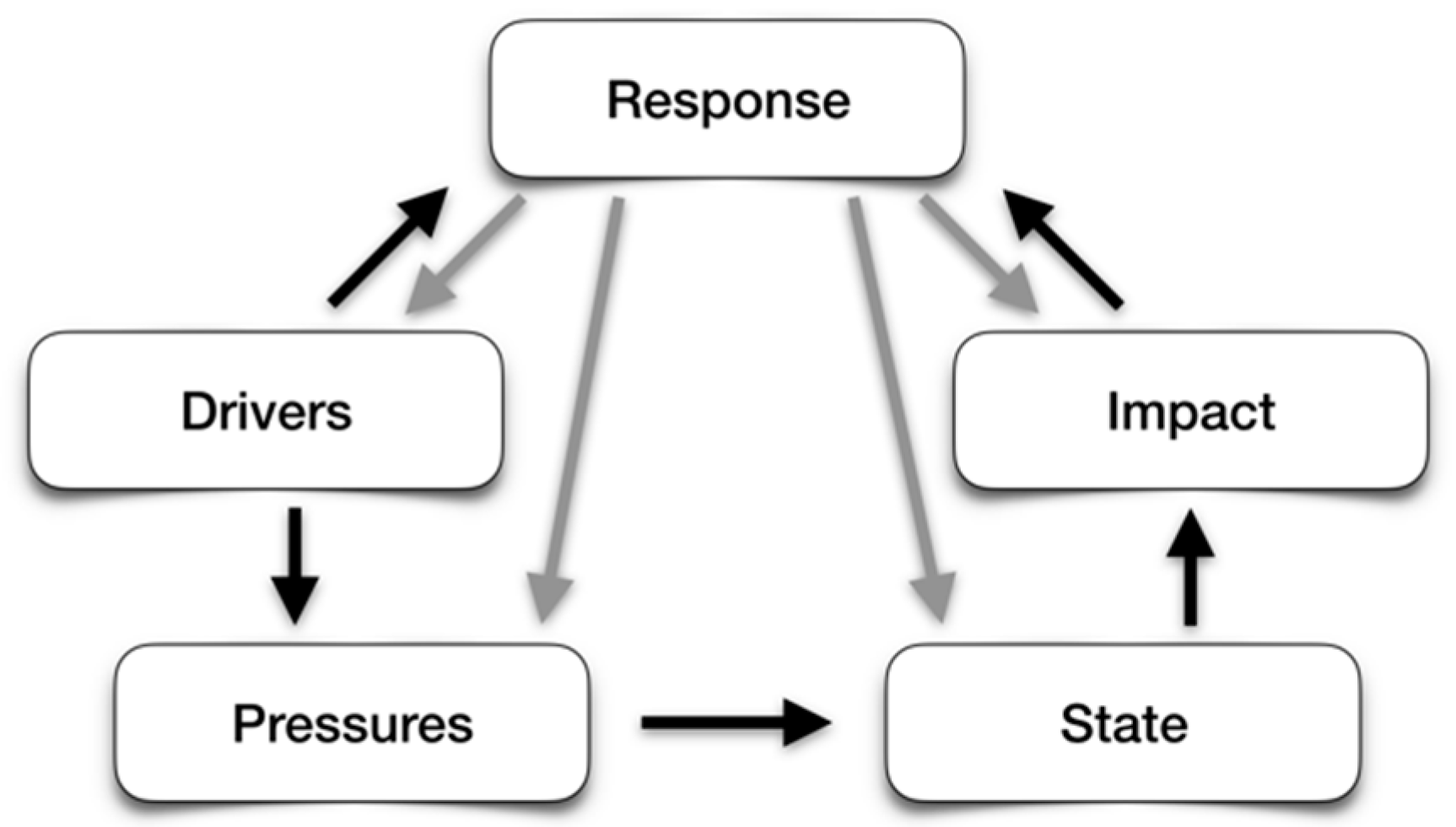
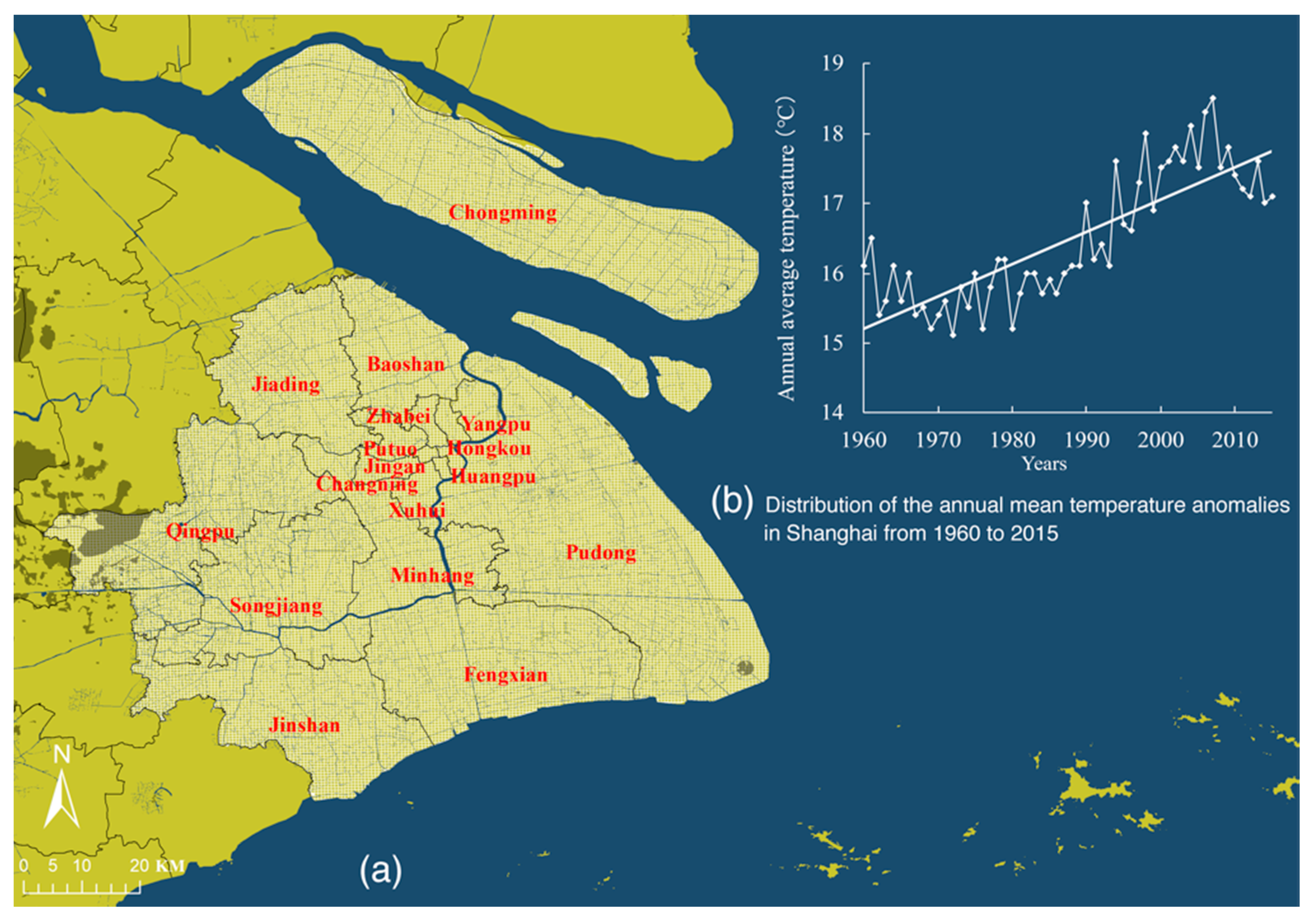

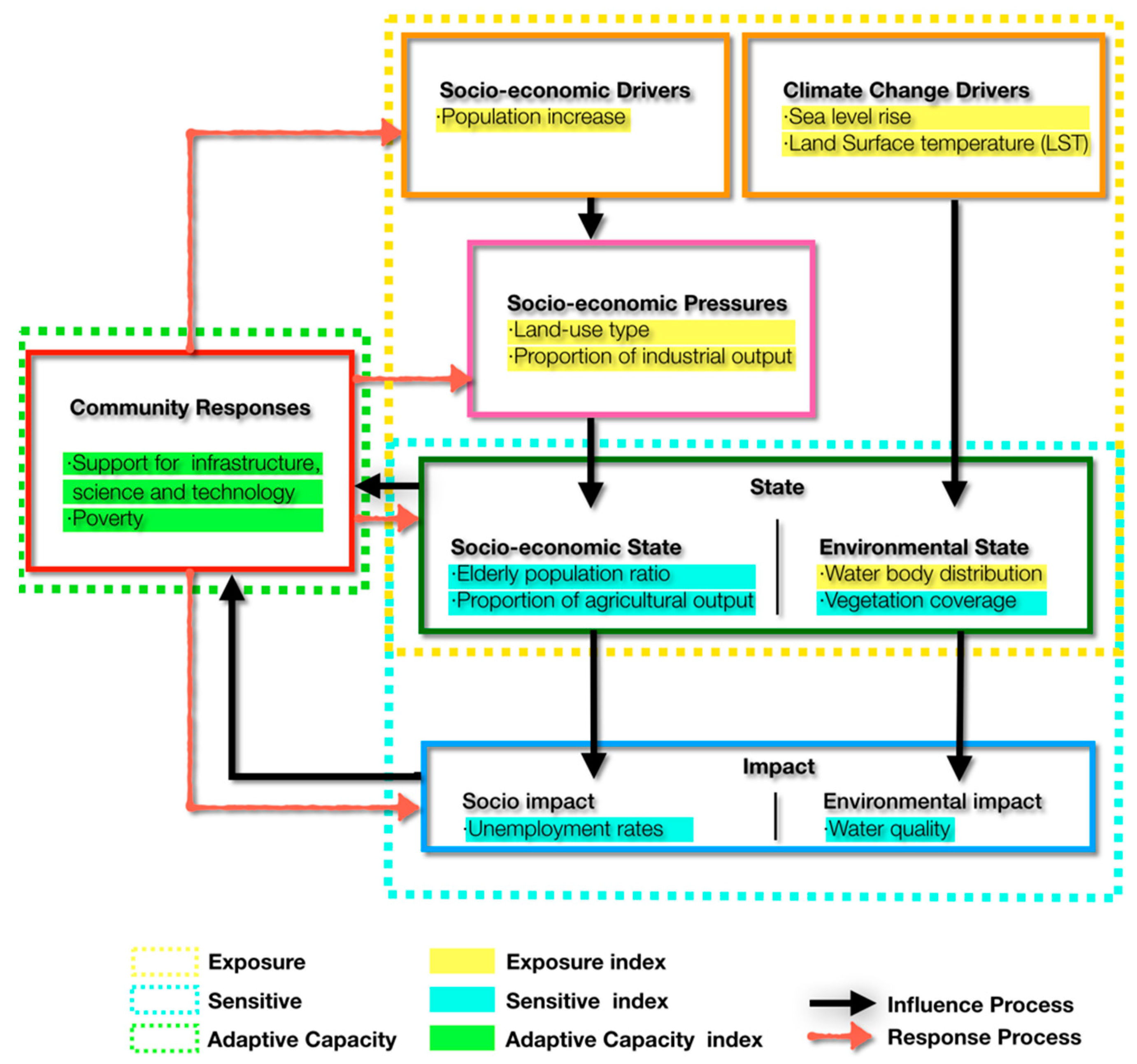
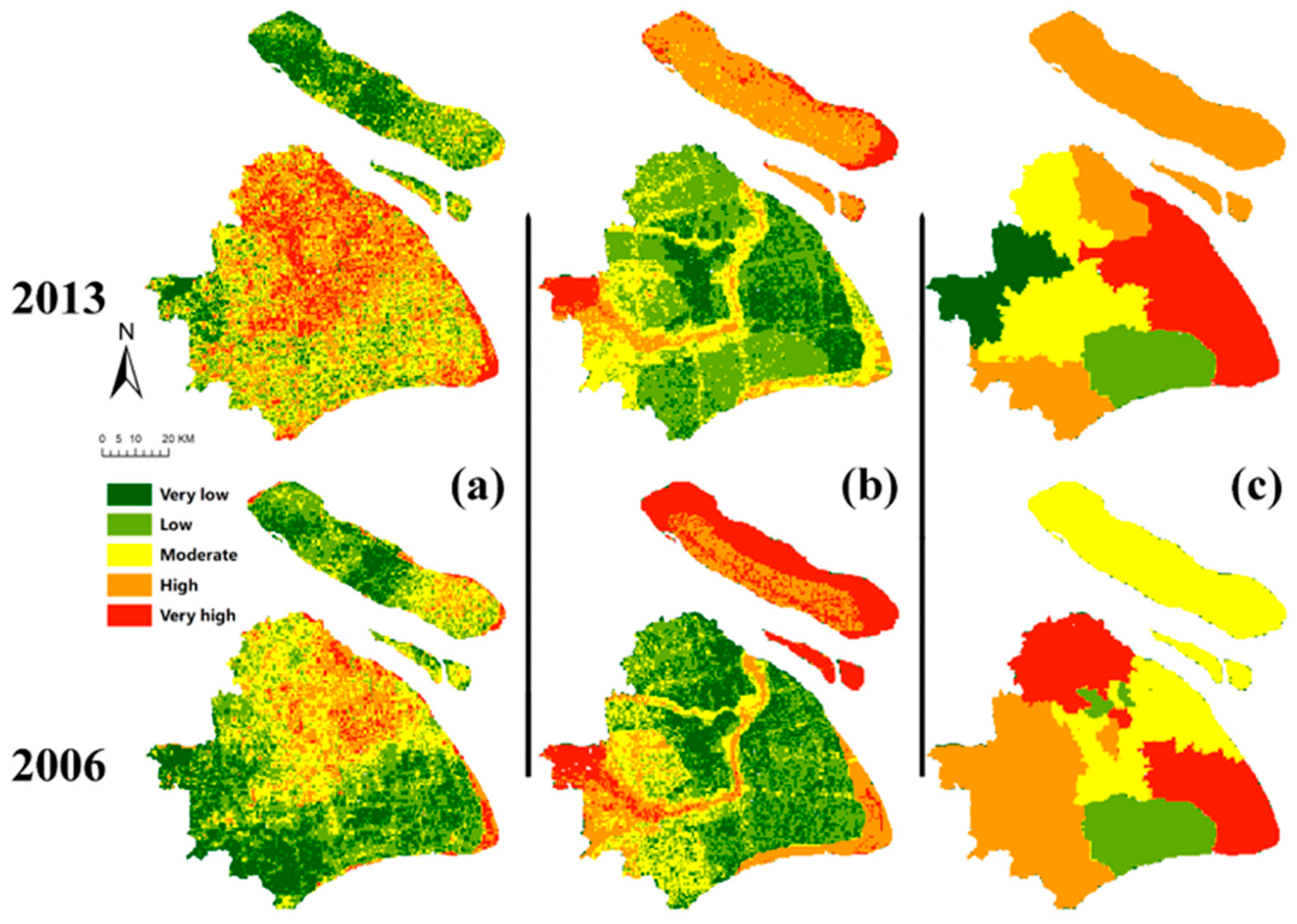
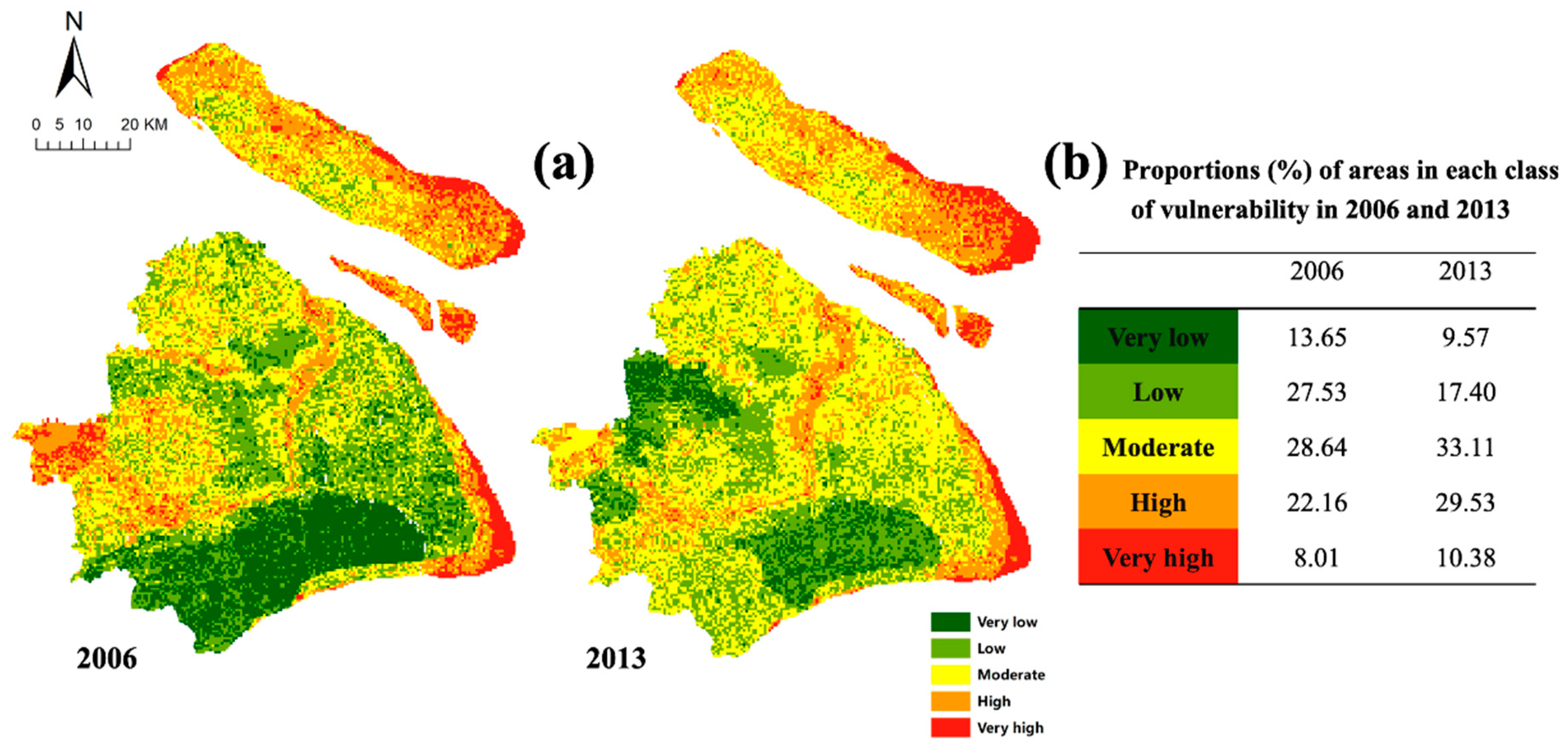


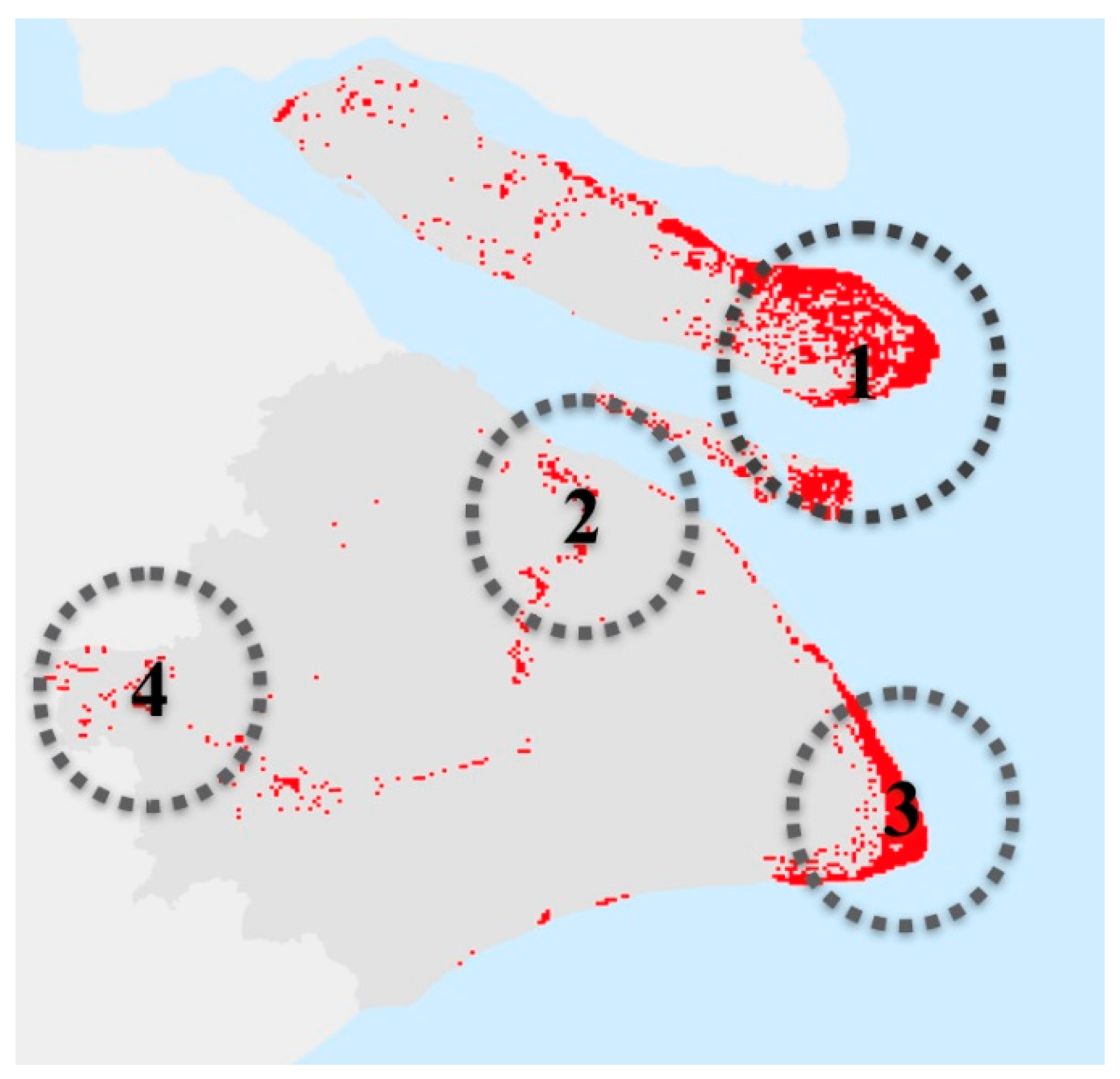
© 2019 by the authors. Licensee MDPI, Basel, Switzerland. This article is an open access article distributed under the terms and conditions of the Creative Commons Attribution (CC BY) license (http://creativecommons.org/licenses/by/4.0/).
Share and Cite
He, C.; Zhou, L.; Ma, W.; Wang, Y. Spatial Assessment of Urban Climate Change Vulnerability during Different Urbanization Phases. Sustainability 2019, 11, 2406. https://doi.org/10.3390/su11082406
He C, Zhou L, Ma W, Wang Y. Spatial Assessment of Urban Climate Change Vulnerability during Different Urbanization Phases. Sustainability. 2019; 11(8):2406. https://doi.org/10.3390/su11082406
Chicago/Turabian StyleHe, Cheng, Liguo Zhou, Weichun Ma, and Yuan Wang. 2019. "Spatial Assessment of Urban Climate Change Vulnerability during Different Urbanization Phases" Sustainability 11, no. 8: 2406. https://doi.org/10.3390/su11082406




